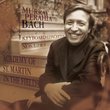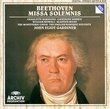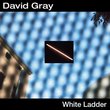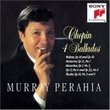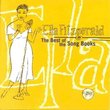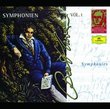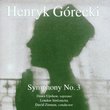| All Artists: Johann Sebastian Bach, Murray Perahia Title: Bach: English Suites Nos. 1, 3 & 6 Members Wishing: 0 Total Copies: 2 Label: Sony Release Date: 3/31/1998 Genre: Classical Styles: Forms & Genres, Suites, Historical Periods, Baroque (c.1600-1750) Number of Discs: 1 SwapaCD Credits: 1 UPC: 074646027622 |
Search - Johann Sebastian Bach, Murray Perahia :: Bach: English Suites Nos. 1, 3 & 6
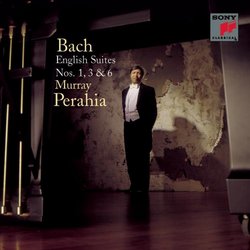 | Johann Sebastian Bach, Murray Perahia Bach: English Suites Nos. 1, 3 & 6 Genre: Classical
Why hasn't Murray Perahia recorded Bach before? The pianist imbues the quicker movements with more excitement and rhythmic drive than Andras Schiff, and greater coloristic and emotional range than Glenn Gould, although M... more » ![header=[] body=[This CD is available to be requested as disc only.]](/images/attributes/disc.png?v=5b450bfd) ![header=[] body=[This CD is available to be requested with the disc and back insert.]](/images/attributes/disc_back.png?v=5b450bfd) ![header=[] body=[This CD is available to be requested with the disc and front insert.]](/images/attributes/disc_front.png?v=5b450bfd) ![header=[] body=[This CD is available to be requested with the disc, front and back inserts.]](/images/attributes/disc_front_back.png?v=5b450bfd) |
Larger Image |
CD DetailsSynopsis
Amazon.com Why hasn't Murray Perahia recorded Bach before? The pianist imbues the quicker movements with more excitement and rhythmic drive than Andras Schiff, and greater coloristic and emotional range than Glenn Gould, although Mieczyslaw Horszowski dances more in the third suite. Perahia views the sarabandes from a monumental angle and brings out their harmonic felicities through his masterful weighing of contrapuntal lines and inner dynamics. The superb sound serves both pianist and composer to the fullest. In sum, a wonderful disc that bodes well for future Perahia Bach releases. We hope. --Jed Distler Similarly Requested CDs
|
CD ReviewsFinely polished beautiful sound, but ultimately a bit dull Bradley P. Lehman | Dayton, VA USA | 02/11/2001 (4 out of 5 stars) "The most obvious thing about these performances is well-polished tone production. Perahia has great fluency and flow, too, making the music sound nearly effortless. His playing is far above mere competence, and sometimes gets into realms of serenity. That is all very good. My main disagreements are with interpretive points.I yearned for more Frenchness, more grace and whimsy tempering the Italianate drive. Perahia's fast tempos sometimes seem headlong and don't breathe. Throughout most of these three suites there could be a lot more rhythmic and dynamic freedom within small groups of notes. More singing, more dance, more spontaneity. Less machine-like perfection! Perahia's treatment of Bach's signed ornamentation is another problem. Every occasion sounds the same as the next one: same speed within the ornament, same number of notes, same even touch. Instead of making the lines sound vocal and free and beautiful, the ornamentation here doesn't seem to add any character. It's as if he knows how to deliver all the notes from the page very nicely, but doesn't quite get the gestural purpose behind the phrases and melodic shapes. It's as if each signed ornament calls the same subroutine to be run in his brain and fingers: output the "correct" notes disregarding context. It's pretty but it's not music.There's a finger slip (or bad edit?) in bar 23 of the first suite's Allemande: at 3'26" of track 2. It's not horrible, but the blemish stands out so much because everything else is so well polished. If instead the performances as a whole had more grace and more grit, a more human casualness, a more speechlike delivery, technical irregularities like this wouldn't draw attention to themselves.Left hand articulation is yet another problem. In too many movements the left hand simply bops along with an absolutely regular detachment, oblivious to that line's own melodic motion or the harmonic functions of its notes. (Cellists playing Baroque music in ensemble works often illustrate this same motoric problem...turn off the brain, bow everything exactly the same. Can't a bass line be musical, too?) Perahia's right hand isn't immune to this staccato tendency, either: he too often ignores Bach's carefully marked slurs of two or four notes (especially in the A-major suite), replacing them with a pokey evenness. Where's the grace?Continuing to pick nits, I think Perahia's tempo scheme in suite 6's Prelude is misguided: the second section is certainly lively, but shouldn't the first section be more nearly the same in character? (Bach's "allegro" marking at that point doesn't mean "suddenly take off like horses out of a gate" -- it merely means "resume stricter tempo after relaxing in the previous bar's cadence".) That's yet another symptom of blithe literalism in reading the notation...the same way Richter and MANY other pianists interpret Bach. Literal rhythms, literal articulations, literal tempo choices, all based on 19th century ideals rather than on 17th or 18th century notions of rhetoric and expression.Performances of this type ultimately make Bach sound academic: get all the notes, rhythms, and speeds more or less correct, and hope that that's good enough. Unfortunately it's not. Sure, one can strive for a lovely spirituality as Perahia does, but it means a lot more if there's also an engaging earthiness to it. The spirit and mind are more easily nudged when the body is also engaged. Even the most placid lake has ripples in it, and the ripples make the lake seem alive. Perahia's performances don't sound inhuman (like Pogorelich's), but they could still breathe a lot more naturally. In both the big picture and from phrase to phrase, they're just a bit too generic. The performances don't sound like living things existing in time. Rather, they sound like stylized intellectual constructions, sterile geometric objects. How about more particular reactions to the moments, and more sense of fun? How about some emotion?After all those complaints I still give this disc four stars instead of three. One could do a LOT worse in Bach-on-the-piano. (If the instrument has to be a piano, which is inherently less interesting tonally than a good harpsichord in this repertoire, it might as well be played this beautifully.)Perahia lets Bach speak on his own, straightforwardly, at least as far as he understands the notation (and he obviously understands the compositional syntax better than Richter or Pogorelich or Gould did!). Other than his hot-staccato touch that he uses as an occasional tone color (as many other pianists also apply to Bach), he doesn't do anything infuriatingly odd. Perahia does well in the middle of the road. It's a pleasant way to play Bach, if not the most immediately engaging. And these performances wear well on repeated listening." Magnificent Bach on a Modern Piano! Russel E. Higgins | 03/02/2000 (5 out of 5 stars) "I would urge any music lover with a perceptive interest in Bach's keyboard music to buy the two CD's of the English Suites by Murray Perahia. It is difficult to conceive how these suites can be played any more beautifully and sensitively. I am one of those who believes that Bach sounds wonderful on a modern piano, and have collected recordings by Gould, Horszowki, Schiff, and Richter. Each of these magnificent pianists bring a special magical quality to the music. Murray Perahia's interpretation of the English Suites, however, is even more magical to me than any others. His tempos and rhythms are perfect for the music. Technically, he is capable of playing the most complex figurations with grace and style. (Listen to his amazing trills which are relaxed and perfectly realized.) Most importantly, his playing contains a profound human quality that transcends all the technical difficulties of the music. Like all great artists, he makes the most difficult figuarations appear to be easy and graceful to play. I urge any lover of Bach music to buy this CD as soon as possible. I am certain you will want to buy the second volume (English Suites #2, #4, and #5), and also his magnificent Handel-Scarlatti album. Then do as I did --- buy Murray Perahia's new "Songs without Words" album and listen to the magic he works with Bach's chorale-preludes, and with Mendelssohn and Schubert, all in magnificent sound from Sony. I'm certain these recordings will brighten up your days!" A Wonderful Recording! kiwimuzo | 02/24/2000 (5 out of 5 stars) "Perahia really amazed me with his ability to incorporate and mingle energy with delicacy into Bach. His performance is precise yet poetic, creating an overall refreshing, clear, and refined atmosphere."
|

 Track Listings (22) - Disc #1
Track Listings (22) - Disc #1